JAJSDI1 June 2017 LM324-MIL
PRODUCTION DATA.
- 1 特長
- 2 アプリケーション
- 3 概要
- 4 改訂履歴
- 5 Pin Configuration and Functions
- 6 Specifications
- 7 Parameter Measurement Information
- 8 Detailed Description
- 9 Application and Implementation
- 10Power Supply Recommendations
- 11Layout
- 12デバイスおよびドキュメントのサポート
- 13メカニカル、パッケージ、および注文情報
パッケージ・オプション
デバイスごとのパッケージ図は、PDF版データシートをご参照ください。
メカニカル・データ(パッケージ|ピン)
- YS|0
サーマルパッド・メカニカル・データ
発注情報
6 Specifications
6.1 Absolute Maximum Ratings
over operating free-air temperature range (unless otherwise noted)(1)| MIN | MAX | UNIT | ||
|---|---|---|---|---|
| Supply voltage, VCC(2) | ±16 | 32 | V | |
| Differential input voltage, VID(3) | ±32 | V | ||
| Input voltage, VI (either input) | –0.3 | 32 | V | |
| Duration of output short circuit (one amplifier) to ground at (or below) TA = 25°C, VCC ≤ 15 V(4) | Unlimited | |||
| Operating virtual junction temperature, TJ | 150 | °C | ||
| Case temperature for 60 seconds | FK package | 260 | °C | |
| Storage temperature, Tstg | –65 | 150 | °C | |
(1) Stresses beyond those listed under Absolute Maximum Ratings may cause permanent damage to the device. These are stress ratings only, and functional operation of the device at these or any other conditions beyond those indicated under Recommended Operating Conditions is not implied. Exposure to absolute-maximum-rated conditions for extended periods may affect device reliability.
(2) All voltage values (except differential voltages and VCC specified for the measurement of IOS) are with respect to the network GND.
(3) Differential voltages are at IN+, with respect to IN−.
(4) Short circuits from outputs to VCC can cause excessive heating and eventual destruction.
6.2 ESD Ratings
| VALUE | UNIT | |||
|---|---|---|---|---|
| V(ESD) | Electrostatic discharge | Human-body model (HBM), per ANSI/ESDA/JEDEC JS-001(1) | ±500 | V |
| Charged-device model (CDM), per JEDEC specification JESD22-C101 | ±1000 | |||
(1) JEDEC document JEP155 states that 500-V HBM allows safe manufacturing with a standard ESD control process.
6.3 Recommended Operating Conditions
over operating free-air temperature range (unless otherwise noted)| MIN | MAX | UNIT | ||
|---|---|---|---|---|
| VCC | Supply voltage | 3 | 30 | V |
| VCM | Common-mode voltage | 0 | VCC – 2 | V |
| TA | Operating free air temperature | 0 | 70 | °C |
6.4 Thermal Information
| THERMAL METRIC(1) | D (SOIC) | DB (SSOP) | N (PDIP) | NS (SO) | PW (TSSOP) | J (CDIP) | W (CFP) | UNIT | |
|---|---|---|---|---|---|---|---|---|---|
| 14 PINS | 14 PINS | 14 PINS | 14 PINS | 14 PINS | 14 PINS | 14 PINS | |||
| RθJA(2)(3) | Junction-to-ambient thermal resistance | 86 | 86 | 80 | 76 | 113 | — | — | °C/W |
| RθJC(4) | Junction-to-case (top) thermal resistance | — | — | — | — | — | 15.05 | 14.65 | °C/W |
(1) For more information about traditional and new thermal metrics, see the Semiconductor and IC Package Thermal Metrics application report.
(2) Short circuits from outputs to VCC can cause excessive heating and eventual destruction.
(3) Maximum power dissipation is a function of TJ(max), RθJA, and TA. The maximum allowable power dissipation at any allowable ambient temperature is PD = (TJ(max) – TA)/RθJA. Operating at the absolute maximum TJ of 150°C can affect reliability.
(4) Maximum power dissipation is a function of TJ(max), RθJA, and TC. The maximum allowable power dissipation at any allowable case temperature is PD = (TJ(max) – TC)/RθJC. Operating at the absolute maximum TJ of 150°C can affect reliability.
6.5 Electrical Characteristics
at specified free-air temperature, VCC = 5 V (unless otherwise noted)| PARAMETER | TEST CONDITIONS(1) | TA(2) | MIN | TYP(3) | MAX | UNIT | ||
|---|---|---|---|---|---|---|---|---|
| VIO | Input offset voltage | VCC = 5 V to MAX, VIC = VICRmin, VO = 1.4 V |
25°C | 3 | 7 | mV | ||
| Full range | 9 | |||||||
| IIO | Input offset current | VO = 1.4 V | 25°C | 2 | 50 | nA | ||
| Full range | 150 | |||||||
| IIB | Input bias current | VO = 1.4 V | 25°C | –20 | –250 | nA | ||
| Full range | –500 | |||||||
| VICR | Common-mode input voltage range | VCC = 5 V to MAX | 25°C | 0 to VCC – 1.5 |
V | |||
| Full range | 0 to VCC – 2 |
|||||||
| VOH | High-level output voltage | RL = 2 kΩ | 25°C | VCC – 1.5 | V | |||
| RL = 10 kΩ | 25°C | |||||||
| VCC = MAX | RL = 2 kΩ | Full range | 26 | |||||
| RL ≥ 10 kΩ | Full range | 27 | 28 | |||||
| VOL | Low-level output voltage | RL ≤ 10 kΩ | Full range | 5 | 20 | mV | ||
| AVD | Large-signal differential voltage amplification | VCC = 15 V, VO = 1 V to 11 V, RL ≥ 2 kΩ |
25°C | 25 | 100 | V/mV | ||
| Full range | 15 | |||||||
| CMRR | Common-mode rejection ratio | VIC = VICRmin | 25°C | 65 | 80 | dB | ||
| kSVR | Supply-voltage rejection ratio (ΔVCC /ΔVIO) |
25°C | 65 | 100 | dB | |||
| VO1/ VO2 | Crosstalk attenuation | f = 1 kHz to 20 kHz | 25°C | 120 | dB | |||
| IO | Output current | VCC = 15 V, VID = 1 V, VO = 0 |
Source | 25°C | –20 | –30 | –60 | mA |
| Full range | –10 | |||||||
| VCC = 15 V, VID = –1 V, VO = 15 V |
Sink | 25°C | 10 | 20 | ||||
| Full range | 5 | |||||||
| VID = –1 V, VO = 200 mV | 25°C | 12 | 30 | μA | ||||
| IOS | Short-circuit output current | VCC at 5 V, VO = 0, GND at –5 V |
25°C | ±40 | ±60 | mA | ||
| ICC | Supply current (four amplifiers) | VO = 2.5 V, no load | Full range | 0.7 | 1.2 | mA | ||
| VCC = MAX, VO = 0.5 VCC, no load |
Full range | 1.4 | 3 | |||||
(1) All characteristics are measured under open-loop conditions, with zero common-mode input voltage, unless otherwise specified. MAX VCC for testing purposes is 30 V.
(2) Full range is 0°C to 70°C for LM324-MIL.
(3) All typical values are at TA = 25°C
6.6 Operating Conditions
VCC = ±15 V, TA = 25°C| PARAMETER | TEST CONDITIONS | TYP | UNIT | |
|---|---|---|---|---|
| SR | Slew rate at unity gain | RL = 1 MΩ, CL = 30 pF, VI = ±10 V (see Figure 7) | 0.5 | V/μs |
| B1 | Unity-gain bandwidth | RL = 1 MΩ, CL = 20 pF (see Figure 7) | 1.2 | MHz |
| Vn | Equivalent input noise voltage | RS = 100 Ω, VI = 0 V, f = 1 kHz (see Figure 8) | 35 | nV/√Hz |
6.7 Typical Characteristics
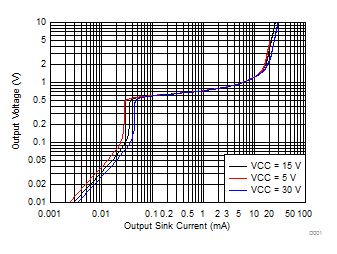
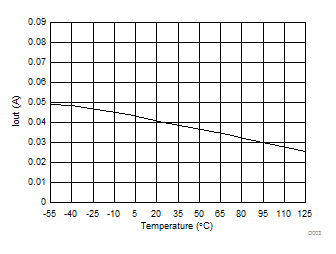
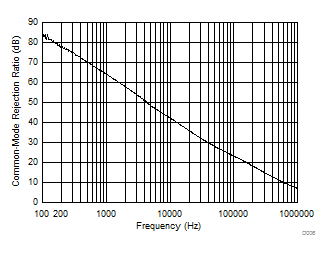
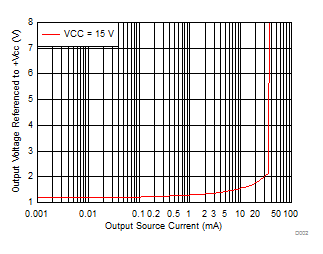
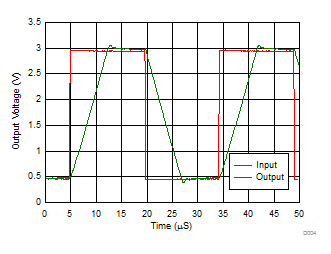
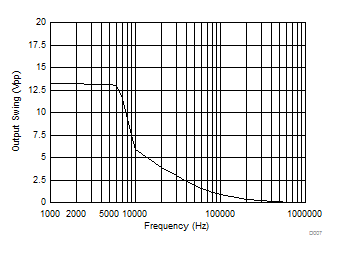
(VCC = 15 V)